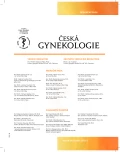Operative vaginal deliveries and their impact on maternal and neonatal outcomes – prospective analysis
Authors:
Petra Morávková 1
; Lukáš Hruban 1
; D. Jančářová 2; Petr Janků 1
; Romana Gerychová 1; Petra Bretová 1
; R. Štěpánová 3; P. Ventruba 1
Authors place of work:
Gynekologicko-porodnická klinika LF MU a FN, Brno, přednosta prof. MUDr. P. Ventruba, DrSc., MBA
1; Neonatologické oddělení LF MU a FN, Brno, primář MUDr. I. Borek
2; Farmakologický ústav LF MU a FN, Brno, přednostka doc. MUDr. R. Demlová, Ph. D.
3
Published in the journal:
Ceska Gynekol 2019; 84(2): 93-98
Category:
Prospektivní studie
Summary
Objective: Evaluation of maternal and neonatal outcomes in operative vaginal deliveries in prospective study analysis.
Design: Prospective case-control study analysis.
Setting: Prospective analysis of 292 operative vaginal deliveries (VEX, forceps) for the period June 2016 – August 2017 from overall 6056 vaginal deliveries. Type and frequency of maternal and neonatal trauma occurence was observed in connection with using vacuum-assisted delivery and forceps delivery, mainly the cephalohematomas and their complications. Collected data were statistically analysed.
Results: In the reported period from overall 6056 deliveries there were 216 vacuumextractions (3.6%) and 72 forceps deliveries (1.2%) performed. Both methods were used in four patients (VEX and forceps). The most frequent trauma in newborns were cephalohematomas. Remarkable cephalohematoma, requiring further observation has occured in 40 newborns (18.5%) after vacuum-assisted delivery and in 5 newborns (6.9%), (p = 0,017) after forceps delivery. Consequential punction of cephalohematoma occured only after vacuumextraction delivery and in 6 newborns (15.0 %). The third degree perineal rupture occured after vacuumextraction in 20 patients (9.3%) and after forceps delivery in 12 patients (16.7%), (p = 0,091). The fourth degree perineal rupture occured only after vacuumextraction and in 1 case (0.5%).
Conclusion: The vacuumextraction compared with forceps is more likely to be associated with the statistically significant incidence of cephalohematomas and their further treatment. Forceps deliveries compared with vacuumextraction are more likely to be associated with the maternal perineal trauma, but the diference was not statistically significant.
Keywords:
vacuum-assisted delivery – forceps delivery – cephalohematoma – neonatal trauma – maternal trauma
Zdroje
1. Ali, UA., Norwitz, ER. Vacuumassisted vaginal delivery. Rev Obstet Gynecol, 2009, 2(1), p. 5–17.
2. Bofill, JA., Rust, OA., Schorr, SJ., et al. A randomized prospective trial of the obstetric forceps versus the M-cup vacuumextractor. Am J Obstet Gynec, 1996, 175, p. 1325–1330.
3. Brichtová, E. Porodní kefalhematomy – punktovat či nepunktovat? Pediatrie pro praxi, 2010, 11(4), s. 252–254.
4. Caughey, AB., Sandberg, PL., Zlatnik, MG., et al. Forceps compared with vacuum: Rates of neonatal and maternal morbidity. Obstet Gynec, 2005, 106, p. 908–912.
5. Davis, DJ. Neonatal subgaleal hemorrhage: diagnosis and management. CMAJ, 2001, 164(10), p. 1452–1453.
6. Doležal, A. Porodnické operace. Praha: Grada Publishing, 2007, s. 306–307.
7. Edozien, LC, Williams, JL., Chatterjee, IC., Hirsch, PJ. Failed instrumental delivery: How safe is the use of a second instrument? J Obstet Gynaecol, 1999, 19(5), p. 460–462.
8. Chalmers, JA., Chalmers, I. The obstetric vacuumextractor is the instrument of first choice for operative vaginal delivery. BJOG, 1989, 96(12), p. 1454–1458.
9. Jeon, J., Na, S. Vacuumextraction vaginal delivery: current trend and safety. Obstet Gynecol Sci, 2017, 60 (6), p. 499–505.
10. Johanson, RB., Heycock, E., Carter, J., et al. Maternal and child health after assisted vaginal delivery: five-year follow up of a randomised controlled study comparing forceps and ventouse. Br J Obstet Gynaecol, 1999, 106, p. 544–549.
11. Johanson, RB., Menon, V. Vacuumextraction vs. forceps for assisted vaginal delivery. Cochrane Database Syst Rev, 2010, 10(11).
12. Macfarlane, AJ., Blondel, B., Mohangoo, AD., et al. Wide differences in mode of delivery within Europe: risk-stratified analyses of aggregated routine data from the Euro-Peristat study. BJOG, 2016, 123(4), p. 559–568.
13. Malik, A., Crowder, D., Barretto, G. Subgaleal hematoma masking fatal complications of cephalhematoma in a preterm infant. Clin Pediatr, 2018, 57(5), p. 593–596.
14. Matas, M., Dort, J., Tobrmanová, H. Přirozený průběh spontánního hojení kefalhematomů. Pediatrie pro praxi, 2014, 15(1), s. 45–46.
15. Morávková, P., Hruban, L., Janků, P., et al. Porodnické vaginální extrakční operace a jejich vliv na traumatismus matky a dítěte, Kniha abstrakt XXXIII. celostátní konference perinatologie a fetomaternální medicíny. Galén, 2016, s. 24.
16. O‘Mahony, F., Hofmeyr, GJ., Menon V. Choice of instruments for assisted vaginal delivery. Cochrane Database Syst Rev, 2010, 10(11).
17. Patel, RR., Murphy, DJ. Forceps delivery in modern obstetric practice. BMJ, 2004, 328(7451), p. 1302–1305.
18. Ross, MG., Fresquez, M., El-Haddad, MA. Impact of FDA advisory on reported vacuum-assisted delivery and morbidity. J Maternal-Fetal Med, 2000, 9(6), p. 321–326.
19. Royal College of Obstetricians and Gynaecologists. Green-top Guideline No. 26: Operative vaginal delivery. London: RCOG, 2011, 19.
20. SOGC Clinical practice guidelines No. 148: Guidelines for operative vaginal birth. Canada, p. 747–753.
21. Šimetka, O. Doporučený postup: Operační vaginální porod. Čes Gynek, 2016, 81(2), s. 93–94.
22. Thomas, J., Paranjothy, S. National sentinel caesarean section audit report. London: RCOG Press, 2001. 117 p.C.
23. Towner, D., Castro, MA., Eby-Wilkens, E., Gilbert, WM. Effect of mode of delivery in nulliparous women on neonatal intracranial injury. N Engl J Med, 1999, 341, p. 1709–1714.
24. Weiss, KJ., Edwards, MS., Hay, LM. Escherichia coli infected cephalohematoma in an infant. Clin Pediatr., 2009, 48(7), p. 763–766.
25. Witby, EH., Griffiths, PD., Rutter, S., et al. Frequency and natural history of subdural haemorrhages in babies and relation to obstetrics factors. Lancet, 2004, 363, p. 846–851.
Štítky
Dětská gynekologie Gynekologie a porodnictví Reprodukční medicínaČlánek vyšel v časopise
Česká gynekologie

2019 Číslo 2
Nejčtenější v tomto čísle
- Ruptura dělohy v těhotenství a při porodu: rizikové faktory, příznaky a perinatální výsledky – retrospektivní analýza
- Sakrokokcygeální teratom
- Porodnické vaginální extrakční operace a jejich vliv na traumatismus matky a dítěte – prospektivní studie
- Nejnovější poznatky o placentě z pohledu imunologie, tolerance a mezenchymálních kmenových buněk
